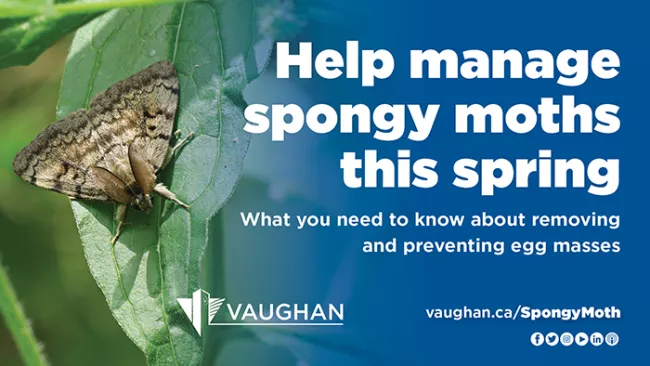Help manage spongy moths this spring
While you get a head start on spring cleaning around the
house, consider tending to trees on your property as well. This season, you may
notice brown- and orange-coloured egg masses on trees throughout Vaughan. These
are most likely spongy moths, formerly known as LDD or
gypsy moths, an invasive species not native to Ontario.
The caterpillars eat leaves from hardwood trees such as oak, maple, birch and poplar, and select shrubs. While forested areas in York Region may be affected, trees in urban areas – including on local and regional roads and on private property – are most at risk. Soil compaction, air pollution and other pests and diseases make trees in urban areas more susceptible to infestation. However, affected trees that are healthy will usually grow a second crop of leaves in the same season.
Spongy moths have natural enemies that help reduce the population in highly infested areas. These include soil-borne bacteria, squirrels, chipmunks, raccoons, skunks, more than 15 species of birds and several native insects. In 2021, City staff noted outbreak levels of NPV virus – a natural and detrimental pathogen to Spongy moth caterpillars but harmless to humans and animals – throughout city-wide “hot spot” locations.
Spongy moths have a four-stage life cycle:
- Stage one: egg mass – from August to May
- Stage two: caterpillar – from May to July
- Stage three: pupa – from June to July
- Stage four: moth – from July to August
City moth control
In 2021, City staff placed
barrier bands on more than 1,200 trees and removed approximately 6,600 egg
masses from more than 900 trees in Vaughan. The City will continue to implement
the following control measures throughout 2022:
- From January to May: The City is manually removing accessible egg masses through scraping and vacuuming in known moth hot-spot areas.
- In May: The City will apply some Btk sprays (a biological control product that is non-toxic to animals, humans, plants and most other insects) from the ground at select park and street tree locations and will inject TreeAzin™ (a biological control product) in trunks of select high-value heritage trees.
City staff continue to track locations of outbreaks to inform potential next steps. Watch this video for more information on spongy moths.
Resident moth control
To help protect trees on your property from these invasive insects, the following precaution can be taken this time of year:
- From January to April: Scrape off and destroy egg masses by submerging them in a bucket of soapy water for at least two days. After that time, discard the solution and egg mixture in the garbage. Doing this will help prevent more caterpillars from hatching in the future.
Ensure you always wear gloves when handling caterpillars and egg masses to avoid an allergic reaction. It is important to look thoroughly on your property for egg masses as they can also be found on benches, firewood, outdoor furniture, swing sets and under the eaves of buildings.
For more information and links to resources, visit vaughan.ca/SpongyMoth, the Ministry of Agriculture, Food and Rural Affair’s webpage or york.ca/LDDMoth.
For updates and news as they happen, subscribe to Vaughan News and follow the official corporate channels on Twitter, Facebook, Instagram and LinkedIn.
-30-

